Homemade chlorophyll powder
Chlorophyll is the plant pigment that gives plants their green color. Chlorophyll powder extracted from plants is often used for coloring of food, cosmetics or soap. As a natural green pigment, chlorophyll is a great natural colorant for use in all-natural products. Unfortunately, its poor stability and low intensity of color limits its use. Products colored with natural chlorophyll cannot hold their green color for long. Chlorophyll decomposes in time, so green color fades and turns to tan color. Exposure to light and high temperature accelerates its decomposition.
Instead of buying chlorophyll powder, a similar product is easy to make at home. Despite the fact that the homemade chlorophyll powder is a little different, it can substitute the commercial powder for many different purposes.
The green chlorophyll powder made in the way presented here is suitable for coloring food, cosmetics or handmade soap. However, be aware that due to the way of how it is obtained, this is not pure chlorophyll but a mixture of various plant compounds with high chlorophyll content. This is because plant material contains a complicated mixture of different compounds, and it is impossible to extract any of them in its pure form outside the laboratory. Chlorophyll molecules are not water-soluble and in plant cells they are bound with proteins. Extraction of pure chlorophyll is only possible in the laboratory by organic solvents and a series of other chemicals. In the laboratory, organic solvents are used to break the chlorophyll-protein bond and dissolve chlorophyll. Later, the chlorophyll solution is treated by other chemicals for purification, extraction and stabilization, and the solvents are removed. Often, chlorophyll extract is combined with a carrier like maltodextrin to create flowable, water-soluble powder which is sold by cosmetic ingredients suppliers.
This homemade chlorophyll powder is not the same as the one made in laboratory conditions because it is extracted only by water and heat, without any use of either organic solvents or laboratory equipment. For this reason, it is not as concentrated and potent as the one made in the laboratory, but it is purely natural from all points of view. Beside chlorophyll, homemade chlorophyll powder also contains proteins, other plant pigments, many other plant compounds and small particles of plant tissue. This product is excellently used in handmade cosmetics and for food coloring.
If you want to use it as a cold-process soap colorant, it is recommended to test it first in a small batch. This powder can be a great natural green colorant for your CP soap, but since it is somewhere “in between” dry green herbs and pure chlorophyll, it behaves more like dry herbs. Therefore, you should eventually expect color fading and possible discoloration.
This powder is not soluble in water and oils. It is oil-dispersible. It will easily mix with oils, but eventually the powder particles will sink to the bottom. Contrary to that, this powder is slightly water-dispersible, and in contact with water it floats on its surface. After vigorous mixing, larger powder particles will sink, but the finer ones will remain on the water surface. Due to this fact, premix your powder with a small portion of oil from your recipe prior to incorporation into the formulation.
How to make homemade nettle chlorophyll powder
500g (1.1 lb) of fresh nettle leaves, processed according to this method, yield around 15-20g (0.5 - 0.7 oz) of chlorophyll powder.
To make your homemade chlorophyll powder, you will need herbs (nettle, alfalfa or spinach are the best choices), water, a stove, an oven and a few simple kitchen utensils. Nothing complicated, as you may notice.
The whole process of making chlorophyll powder at home is a bit time-consuming. It takes a few hours, including oven drying, and it yields a pretty small amount of the final product compared with the amount of fresh herbs used. Anyway, it is worth the effort for people who like making stuff like these on their own or for those who, for any reason, cannot buy commercial chlorophyll powder.
To make chlorophyll powder, choose herbs which are known by their high chlorophyll content like spinach, stinging nettle or alfalfa. These herbs are a commercial source of chlorophyll and chlorophyllin used as colorants in foods and medicines. It is important to use edible herb species from organic growth to avoid risk of poisoning by toxic plants or pollutants.
The highest content of chlorophyll is found in fully developed leaves from the middle section of the plant. Plants grown in semi-shade contain more chlorophyll than the ones grown in full sun. Avoid stems, very young leaves on the plant top, the oldest leaves from bottom sections of the plant and damaged or spotted leaves. The leaves have the highest chlorophyll content at the very beginning of flowering.
Wash the herbs thoroughly and handle them in the same manner as if you would prepare any other food, primarily for the reason of using the powder for food coloring, or for any other purpose – e.g. making cosmetic or bath products.
This method for homemade extraction of green color powder is based on the following three steps:
1) Crush/blend fresh plant tissue thoroughly to obtain puree and then filtrate its liquid portion
2) Curdle the chlorophyll-holding proteins by heat and separate them from the liquid
3) Dry and powder the curdled extract
Procedure:
- Wash 500g (1.1 lb) of fresh, fully developed, healthy nettle leaves. Use gloves to avoid skin irritation caused by nettle stings.
- Blend the nettle leaves thoroughly in a blender to make puree. For easier blending add 1lit (4 cups) of water. The water should be cold. It is essential not to add any heat during these first steps of extraction. Blend it in small portions according to the capacity of your blender. The amount of added water is not important because it will be strained out later, but blending is much easier if you use at least twice as much (by weight) water as nettle leaves.
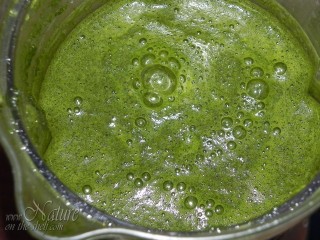
- Strain the nettle puree through a cheese cloth and collect the liquid extract. The strained extract contains chlorophyll, so squeeze the cloth containing puree with hands to collect as much extract as possible.
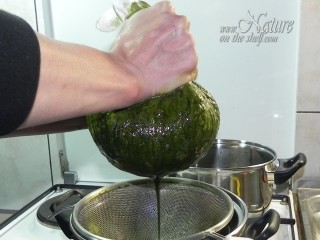
The obtained liquid extract is deep green and turbid. Discard solid particles left in the cheese cloth.
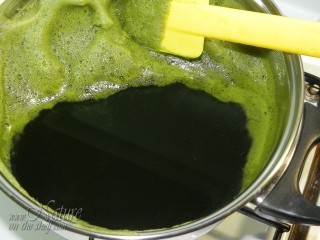
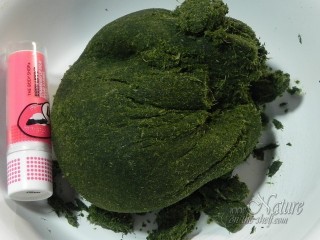
- Bring to boil the collected liquid extract over medium heat, which will curdle the chlorophyll-holding proteins in the extract. Green curdles containing chlorophyll will appear on top of the clarified reddish liquid. Let it boil for 2-3 minutes until curdles form.
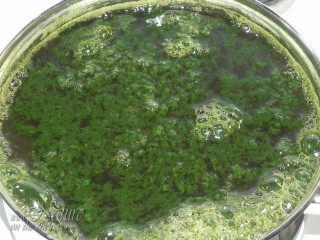
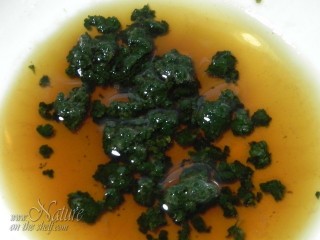
- Strain the chlorophyll curdles and press them to squeeze excess liquid. Discard the reddish-brown liquid.
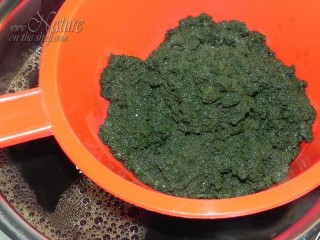
Gently wash the chlorophyll curdles in cold water and strain them through a cheese cloth. Squeeze excess liquid by hand. This process will remove a significant part of water-soluble red pigments, so the color of the chlorophyll powder will be brighter green.
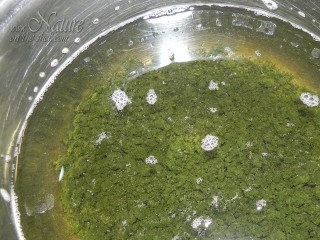
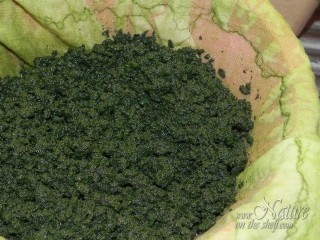
- Spread the wet, green curdles in a very thin layer on wax paper and place them in the oven to dry.
- Dry them in the oven on 50oC (122oF) for 1-2 hours or until dry. The oven should be slightly open to allow moisture to escape.
- The extract is dry when the granules are ‘rock hard’ and dark, almost black.
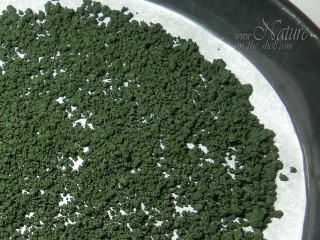
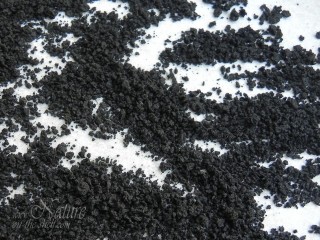
Wet chlorophyll curdles (left) and Dried chlorophyll curdles (right)
- Grind the dry extract with a coffee grinder. The coffee grinder will crush the hard particles but the powder will still be coarse and scratchy, so it must be further processed to finer powder.
- Continue with grinding by hand, using a pestle and a mortar to make fine powder.
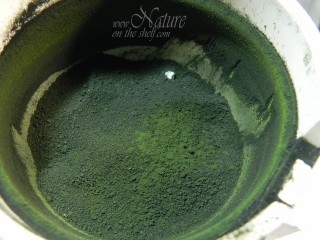
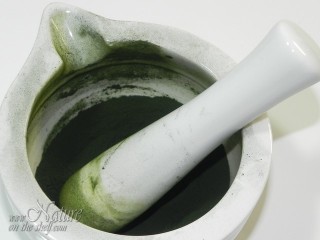
The finely powdered chlorophyll extract colorant will be of forest green color.
In the end, 500g (1.1 lb) of fresh nettle leaves yield around 15-20g (0.5 - 0.7 oz) of chlorophyll powder. It seems a very low yield considering the amount of fresh nettle leaves and hours of patient work to make the powder. However, when we take into account how tiny the chlorophyll amount is in fresh leaves, and also how much of chlorophyll is discarded during the process, this turns out to be a reasonable yield. Chlorophyll content in fresh leaves varies significantly, depending of many factors. Fresh nettle leaves usually contain 0.1-0.3% of chlorophyll. It is obvious that even such a small amount of powder contains a high proportion of plant compounds other than chlorophyll.
When chlorophyll is extracted by water, a large portion of it remains in the discarded hard portion of the puree, so the chlorophyll yield is low. The amount of powder obtained by this method is also very small because it is obtained only from the green liquid. Predominant constituents of homemade chlorophyll powder are proteins and other plant compounds, but the powder is still concentrated and represents a healthy natural green colorant for use in food, all-natural cosmetics, soap and similar homemade products.
